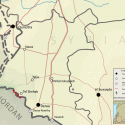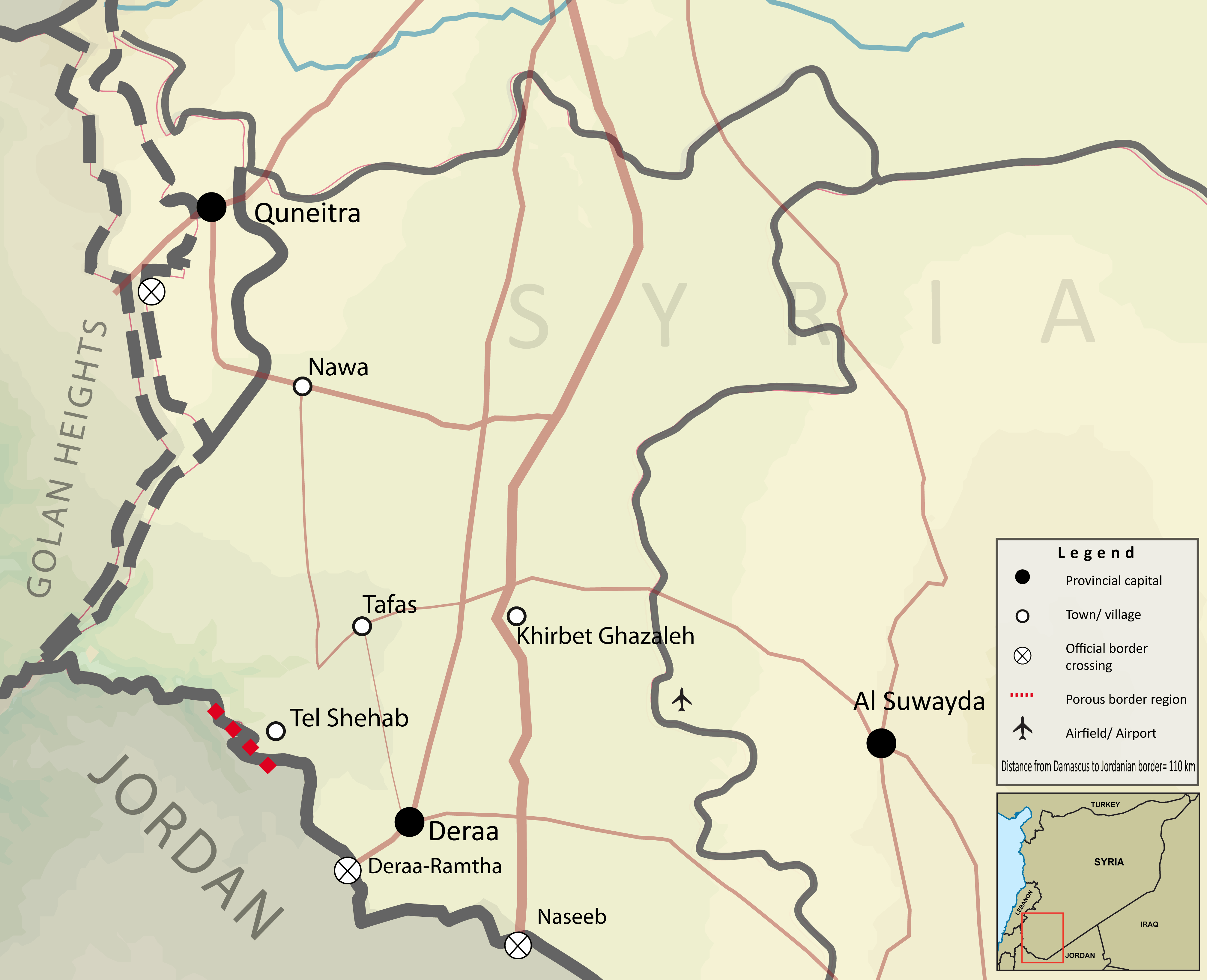 |
 |
Update: Syria's Southern Battlefront

Despite limited media coverage, Deraa is one of the most contested battlefronts in Syria. Deraa province, where the uprising began, has been second only to Damascus in the number of kinetic incidents throughout the month of September.[1] In addition to giving insight into the current state of play between regime and rebel forces in the war, the unfolding dynamics among rebel groups in Deraa serve as indicators for how the armed opposition is taking form in Syria’s southern front. Coordinated, sophisticated operations in Deraa demonstrate the continued capacity for rebel collaboration, as well as a shift in the power dynamics among the various groups operating in the province. Jabhat al-Nusra (JN) in particular has emerged as a prominent player. Jabhat al-Nusra’s prominence in Deraa, particularly their willingness to work with civilian governance structures, indicates that the group has been able to adapt to the specific local conditions present in this conflict arena.
Pounding of the Fortresses
On September 28, 2013, Jabhat al-Nusra, in coordination with the Al-Haramein Brigades of the Ahrar al-Sham Islamic Movement and other rebel groups, seized control of the Deraa-Ramtha post along the Jordanian border in operation “Pounding of the Fortresses.”[2] A day after the operation began, Abu Anass, a JN leader in southern Deraa, appeared in an interview that was broadcast on an FSA-affiliated YouTube channel to describe how JN’s engineer corps covertly moved to the customs office of the border crossing and placed numerous explosives along the exterior wall. JN fighters then detonated the explosives, destroying the wall and allowing assault squads to raid the customs building and take control of it. JN fighters were also able to take control of a nearby mosque and several buildings around the customs office.[3] The maneuvers that Abu Anass described indicate a high level of sophistication in operational planning.
While “Pounding of the Fortresses,” the named JN operation, focused on the border areas around Deraa city, simultaneous operations by other rebel groups led to a notable rebel advance throughout the province. Following the seizure of the border crossing, rebels captured the Masakin Jalin and al-Fiqia checkpoints.[4] On September 29, 2013, several rebel groups announced another joint operation called the “Battle of Uniting Ranks.”[5] Rebel forces under this joint operation included affiliates of the Free Syria Army (FSA), the Syrian Islamic Front (SIF), and Ahrar al-Sham and have launched attacks on an army base and military barracks in Tafas, a town northwest of Deraa city. FSA-affiliated rebels have also been fighting around the town of Nawa since mid-July, with the aim of opening a military supply line into the town.[6]
Though the seizure of the Deraa-Ramtha border crossing has been widely reported, its strategic advantage is largely symbolic. The Jordanian government closed the crossing almost two years ago and rebels have held the porous border area around the nearby town of Tel Shahab since March.[7] The frequently stated aim of ongoing operations by rebel fighters is to remove regime positions which divide Deraa into the eastern and western areas. This would allow the rebels to control a swath of territory across southern Deraa in which they can exercise freedom of movement. In aggregate, recent gains in Deraa increase rebel groups’ control of a contiguous area which can potentially function as a launching pad for a push into Damascus.
Regime Response
As rebels have consolidated their hold over southern Deraa, regime strikes have focused on limiting their capacity to advance towards Damascus. The regime has intensified bombardments and air raids on towns which lie on critical supply lines, particularly those between Deraa city and Damascus.[8] This strategy is in line with regime strategy in northern part of the country, where airstrikes and bombardments also focus on cutting off supply lines.[9] Unlike recent battles in northern Syria, where irregular forces such as the National Defense Force (NDF) fighters provide support to the Syrian Arab Army (SAA), regime forces in Deraa appear to be composed primarily of SAA troops. This may be attributed to the fact that Deraa province has historically been heavily militarized due to its proximity with Israel, and these larger SAA contingents need less reinforcement from NDF fighters. It may also suggest that the population in Deraa is generally less supportive of the regime and therefore unlikely to mobilize in pro-regime militias. In mid-September, Abu Hajjar, a commander from the Shi‘a militia Liwa al-Zulfiqar died in Deraa province.[10] Liwa al-Zulfiqar emerged in June 2013 and is closely tied to Liwa Abu Fadl al-Abbas, a Shi‘a militia group comprised of Iraqi and Syrian militants with strong ties to Iran.[11] The group’s presence in Deraa suggests that the regime still needs to supplement traditional forces with the support of paramilitary fighters in the area.
Rebel power dynamics
In March 2013, rebel forces launched a similar campaign to take control of the strategic border area in Deraa province and succeeded in establishing a 25 km swath of territory adjacent to the border with Israel.[12] Rebels secured key supply lines leading into Deraa city while JN and the Martyr of Yarmouk brigade fighters seized an important air defense base on the Damascus-Amman highway.[13] Later that week, the Fajr al-Islam brigade captured the town of Da’el which lies on the Damascus-Deraa highway and the Fajr al-Islam and Moataz Billah brigades captured the border post at Tel Shehab, northwest of Deraa city.[14] The regime, however, launched a successful counteroffensive, ultimately capturing the town of Khirbet Ghazaleh, giving access to the Damascus-Amman highway. This access provides a resupply route into Deraa, allowing the regime to continue bombardments against rebel positions throughout the southern area of the province.[15] Although rebels were unable to withstand the regime’s counteroffensive, rebel operations in March demonstrated enhanced capabilities of groups associated with the Supreme Military Command to coordinate effectively with Jabhat al-Nusra and other independent groups on the battlefield.
The most recent offensive demonstrates a continued capacity for such cooperation. When asked by Al-Jazeera about relations among rebel factions, JN military commander for eastern Deraa, Abu Omar, said “as for all the fighting battalions on the ground, there is good cooperation and there are no conflicts.”[16] Notably, following operation “Pounding of the Fortresses,” two prominent JN figures gave interviews, one with a pro-FSA channel and one with Al-Jazeera, emphasizing the cooperation and lack of conflict between JN and other groups. Although FSA-affiliated groups have been present in much of the fighting, the most sophisticated operations have been spearheaded by JN. Following the formation of new rebel coalitions in regions throughout Syria and the notable absence of one in the south, the leadership role of JN serves as an indicator for how the armed opposition is taking shape in the southern battlefront.[17]
The current offensive does, however, demonstrate shift in the power dynamics among various groups operating in the province. While groups such as the Martyrs of Yarmouk brigade, affiliated with the Supreme Military Command (SMC), and the Fajr al-Islam Brigade, which is affiliated with the SIF, were at the forefront of the March offensive, they appear to have played more marginal roles in the current fighting. Both Ahrar al-Sham and JN, on the other hand, which were not as prominently involved in March, are now key players in important operations. Despite JN’s increased visibility throughout Syria, the nature of JN activity in Deraa differs from that in other battlefronts. On the northern and eastern fronts JN is less emphatic about its collaboration with other groups and is at times antagonistic towards them, as exemplified by recent rebel infighting in Abu Kamal in Deir ez-Zour Province.[18]
In this context, the southern front generates a separate set of dynamics from those in the north and east. Relative to other parts of Syria, civilian governance initiatives have been successful in Deraa by exercising a degree of popular legitimacy which allows them to curb fundamentalist groups.[19] As an International Crisis Group report points out, “more than anywhere else in the country, armed groups emanate from and are accountable to popular movement that shapes their behaviour, in sharp contrast to the free for all characteristic of the northern front.”[20] JN’s behavior in Deraa, demonstrated by its insistence on collaboration and lack of conflict with other rebel groups, indicates that the group is responsive to local conditions and able to “play by the rules” in a given battle space.
[1] Data collected from Sham News Network
[2] In Arabic, the operation is called Dakk al-Husoun. According to JN’s official statement, the other groups involved were al-Qadisiyya Islamic Brigades, Islamic Jerusalem Battalion, and al-Taba'in Islamic Battalion. “Al-Nusra Front Claims Attack Near Syria-Jordan Border, Exchanges Hostage for Imprisoned Woman,” SITE Monitoring Service, September 30, 2013, http://ent.siteintelgroup.com/index.php?option=com_content&view=article&id=12427:al-nusra-front-claims-attack-near-syria-jordan-border-exchanges-hostage-for-imprisoned-woman&catid=7&Itemid=880
[3] YouTube video of Field Commander Abu Anass in the southern region of Deraa, posted by Free Syrian Satellite Channel on September 25, 2013. https://www.youtube.com/watch?v=gfcYvkeEcdo
[4] YouTube videos translated from Arabic. “Free Syria Army Frees the entire Masakin Jalin checkpoint,” Youtube, September 30, 2013. http://www.youtube.com/watch?v=n5ss6mIz_Tk; “Harakat Ahrar al-Sham, shabiha bodies al-Fiqia checkpoint in Deraa,” YouTube, October 1, 2013. http://www.youtube.com/watch?v=jc1CyDTFOaY&feature=youtu.be&desktop_uri=%2Fwatch%3Fv%3Djc1CyDTFOaY%26feature%3Dyoutu.be&app=desktop
[5] In Arabic, operation is called Tawheed al-Sufoof. The groups involved were Liwa Fajr Islam, Liwa Moa’ataz Billah, Liwa al-Karama, Liwa al-Maham al-Khassa (Special tasks), Liwa Ahel Sunna, Katibat Aswad al-Aqsa, Tajamoa’a Ahrar Houran, Katibatr Shouhada Tafess, and Siryat Shaheed Imad al-Natour. The battle of Uniting Ranks document Statement, Halab News, September 28, 2013. http://halabnews.com/wp-content/uploads/2013/09/1380452_556106337790115_1864796265_n.jpg.
[6] Doha Hassan, “FSA Conducting Deraa Offensive,” NOW, September 13, 2013. https://now.mmedia.me/lb/en/nownews/fsa-launches-daraa-offensive; “Series of major battles in Nawa,” YouTube, September 22, 2013. http://www.youtube.com/watch?v=Fb2KR-uw9qA#t=12
[7] “Syrian rebels capture border post near Jordan,” Aljazeera, September 28, 2013.
http://www.aljazeera.com/news/middleeast/2013/09/syrian-rebels-capture-post-near-jordan-border-201392814359692427.html; “Syrian border crossings,” Syria Needs Analysis Project, September 2013. http://reliefweb.int/sites/reliefweb.int/files/resources/syrian_border_crossings.pdf
[8] According to reports on kinetic incidents from Sham News Network, the number of incidents in Deraa has been second only to Damascus throughout the month of September. The towns which have received the brunt of regime attacks are al-Sheikh Maksin, Tafas, Nawa, and Dael.
[9] Isabel Nassief, “The Regime Gains Ground on the Coast,” Institute for the Study of War, August 22, 2013. http://www.understandingwar.org/backgrounder/regime-regains-ground
[10] Death of Abu Hajjar, see https://twitter.com/PhillipSmyth/status/384767794308337664
[11] For more information on Liwa al-Zulfiqar see Phillip Smyth, “Hizballah Cavalcade: Liwa’a Zulfiqar: Birth of A New Shia Militia in Syria?” Jihadology. http://jihadology.net/2013/06/20/hizballah-cavalcade/. Death of Abu Hajjar, see https://twitter.com/PhillipSmyth/status/384767794308337664. For more information on Abu al-Fadl al-Abbas Brigade see Will Fulton, Joseph Holliday, and Sam Wyer, “Iranian Strategy in Syria,” Institute for the Study of War, May 2013.
[12] Jonathan Dupree, “Syria Update: The Southern Battlefronts,” Institute for the Study of War, April 5, 2013. http://www.understandingwar.org/backgrounder/syria-update-southern-battlefronts
[14] Dupree, “Syria Update: The Southern Battlefronts.”
[15] Erika Solomon, “Syria rebels seize southern base, border area,” Reuters, March 23, 2013. http://www.reuters.com/article/2013/05/08/us-syria-crisis-town-idUSBRE94703H20130508
[16] “Presentation of Abu Omar, commander at the front of the victory to talk about the battles in Daraa and on the subject of delegitimizing the Coalition,” Aljazeera, September 28,2013. http://www.youtube.com/watch?v=B3lMtG592lg&feature=youtu.be
[17] For more information see: Valerie Szybala, “Developments in Syria’s Armed Opposition,” ISW Syria Blog, October 4, 2013. http://iswsyria.blogspot.com/2013/10/developments-in-syrias-armed-opposition.html and Szybala, “The Islamic Alliance Emerges,” Institute for the Study of War, September 27, 2013. http://www.understandingwar.org/backgrounder/islamic-alliance-emerges
[18] Hassan Hassan, “Rebel vs. Rebel,” Foreign policy, September 18, 2013. http://www.foreignpolicy.com/articles/2013/09/18/rebel_vs_rebel_syria_jihadists_groups?page=full
[19] “Daraa: Building a New Syrian State,” Syria Untold, October 4, 2013. http://www.syriauntold.com/en/story/2013/10/04/5527
[20] “Syria’s Metastasizing Conflicts,” International Crisis Group, June 27, 2013, pg. 12.
